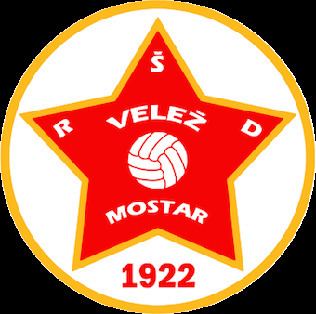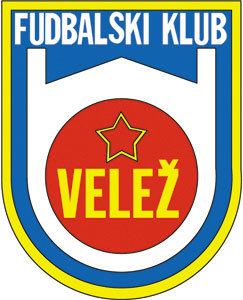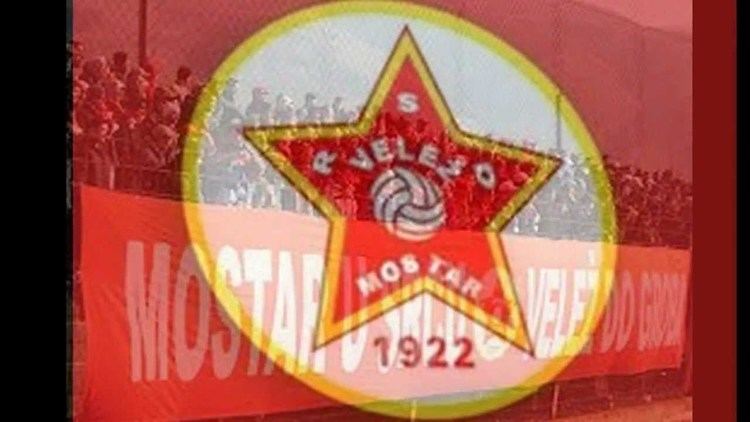Nickname(s) Rođeni Chairman Berin Alagić Founded 26 June 1922 | Ground Capacity 7,000 Manager Tojaga Zijo Ground Vrapčići Stadium | |
 | ||
League First League of the Federation of Bosnia and Herzegovina | ||
Fudbalski Klub Velež Mostar (English: Football Club Velež Mostar) is a professional football club based in Mostar, Bosnia and Herzegovina, and is one of the most successful clubs from Bosnia and Herzegovina. It was founded on 26 June 1922. The club currently plays at Vrapčići (7,000), but its historic stadium is the Bijeli Brijeg (25,000). Due to the divisions between Bosniak and Croat territories, FK Velež Mostar lost its previous home ground of Bijeli Brijeg Stadium. That stadium was largely used by FK Velež Mostar during the glory days for the club, when they triumphed in an 1981 and 1986 Yugoslav cups. The club also reached quarter-final stage of 1974–75 UEFA Cup.
Contents
- The first golden era 19671974
- Yugoslav Cup winners and Road to Europe
- UEFA Team Rankings
- Rivalry
- Supporters
- Domestic
- European
- Summary
- By season
- Player records
- Current squad
- References

The club is named after a nearby mountain Velež, which is named after one of the old Slavic gods, Veles.

During the time of former Yugoslavia, Velež was always in the Yugoslav First League and the team often ended the season in the top ten. Velež was the most popular and most successful team from Herzegovina to play in the top Yugoslav League. The team was very popular in Herzegovina, but also had fans all over Yugoslavia, and had a mixture of fans from all three main ethnic groups.

Today, Velež is in the Football Association of Bosnia and Herzegovina and is active in the Premier League of Bosnia and Herzegovina and regardless of the difficult and divisive political situation, still has a mixture of fans from all three main ethnic groups. The team was relegated to the First League of the Federation from the Premier League for the 2004–05 season. However, after two seasons in the second best league, Velež was promoted to the top league in the country in 2006.
In the summer of 2005, the club's assembly returned the five-pointed red star, also known as the petokraka (Bosnian: petokraka), to their logo. The red star has been the symbol of the club since its founding in 1922.
The first golden era (1967–1974)
For the 1967–68 season Velež selected a new coach, former Velež player Sulejman Rebac. He was the second ever Mostar-born coach of Velež. (Haldun Hrvić was the first, when he coached the club from 1961 to 1964). Velež had played 10th the season before, and it was time for a change. The team was getting old with players like Muhamed Mujić nearing the end of their playing careers. Rebac decided to promote young players from the club's youth academy, and the first ones who were brought in were Dušan Bajević and Enver Marić. Despite this, the 1967–68 season was even worse than the previous season with the team finishing 14th.
For the 1968–69 season Rebac brought in Franjo Vladić, Marko Čolić, Jadranko Topić and Vladimir Pecelj from FK Leotar Trebinje. The results improved and Velež finished 8th in the league. The following season 1969–70 was the breakthrough season for Velež with the team finishing third. Dušan Bajević became the joint-top scorer in the league (with Santrač of OFK Beograd), scoring 20 goals. He also made his debut for the Yugoslav national team in 1970.
For the season 1970–71 Velež was determined to bring the league title to Mostar. New players like Marjan Kvesić, Mirko Ćorluka, Dubravko Ledić, Boro Primorac and Aleksandar Ristić from FK Sarajevo were brought in to help clinch the championship. They started the season well with two wins and two draws in their first four games, but the next ten matches brought mixed results. The season turned out to be a big disappointment and Velež eventually finished 8th. The 1971–72 season was a bit better than the previous with the team finishing 6th. The only positive developments that year were that the goalkeeper Enver Marić had become the first-choice goalkeeper for the national team, and that the young left winger Momčilo Vukoje (brought in from Leotar) and Ahmed Glavović had a string of good performances. The team was very young at that time, players' average age was 23–24 years, so their best years were yet to come.
The season 1972–73 was Velež's best ever with the team finishing as runners-up in the league. With two new players, Vahid Halilhodžić and Džemal Hadžiabdić the team was completed, and big results were beginning to show. For instance the team trashed Vardar Skopje 4–0 and in the following game they beat Radnički Niš with also another 4–0 win. By this time everybody knew how the team looked. Enver Marić as goalkeeper, in front of him Džemal Hadžiabdić and Aleksandar Ristić, in front of them two Velež had Boro Primorac, Vladimir Pecelj and Marko Čolić. The five attacking players were Jadranko Topić on the right wing, Momčilo Vukoje on the left wing, Franjo Vladić and Vahid Halilhodžić in the middle and the team's leading goalscorer Dušan Bajević up front.
In the season 1973–74 Velež fought the entire season with Hajduk Split for the first place. There were many games to remember like for example the 31 October when Velez won 5–0 at home against OFK or 4–2 in March 74 at home against Crvena Zvezda (Red Star). For the last match of the season Velez had to play away against FK Sarajevo while Hajduk took on OFK also away. Both teams had 42 points, but Hajduk had better goal difference at the time. Velez managed to defeat Sarajevo 3–1 but Hajduk won their game and became champions. After the season 73–74 Sulejman Rebac left the team as the coach after 8 seasons. For the 1974 FIFA World Cup held in Germany, Enver Marić, Dušan Bajević and Franjo Vladić (the trio nicknamed BMV) were included in the Yugoslav squad and Rebac was one of Yugoslavia's five coaches. Other players in Velež also played for the national team like for instance Boro Primorac who played 14 games, Vahid Halilhodžić who played 15 and scored 7 goals and Džemal Hadžiabdić with 20 games.
Yugoslav Cup winners and Road to Europe
FK Velež Mostar were the only Bosnian side that appeared 4 times in the Yugoslav Cup Grand Final, having won 2; an 1981 and 1986 Yugoslav cup.
In the season 1974–75, Velež reached Cup UEFA quarter finals. In the earlier rounds of the UEFA Cup, Velež eliminated Spartak Moscow, by losing in Russia 3–1 and winning in Mostar 2–0. Velež then eliminated Rapid Vienna, by drawing in Vienna 1–1, and winning in Mostar 1–0. Velež then eliminated Derby County of England by beating them 3–1 in England and 4–1 in Mostar. Velež was finally defeated in the quarter finals by Dutch team Twente by winning 1–0 in Mostar, but losing 2–0 in the Netherlands 2–0. Overall, a successful year for the Mostar Reds. Twente then went on to beat Italian giants Juventus 3–1, 1–0 to reach the UEFA Cup Finals and face Borussia Monchengladbach (0–0, 5–1).
In the season 1987–88, Velež once again did well in the UEFA Cup. In the first round Velež eliminated FC Sion from Switzerland. In Mostar, Velež came away with an easy win 5–0, while in the second leg they were beaten 0–3. In the second round Velež drew Borussia Dortmund from Germany, in the first leg Dortmund defeated Velež 2–0, while in the return leg Velež won 2–1, which was not enough to go through.
In the season 1988–89, Velež once again did well in the UEFA Cup, this time falling short of qualifying for the quarter finals. First, Velež eliminated Apoel from Cyprus (1–0, 5–2). Then Velež defeated FC Os. Belenense from Portugal in dramatic penalty shootouts (5–4). In the third round Velež faced Heart of Midlothian of Edinburgh, Scotland, where Velež was defeated 3–0 in Edinburgh, while in Mostar Velež won 2–1, which was not enough to go through.
UEFA Team Rankings
Since the late 1970s up until the tragic war of 1992, Velež has been consistently ranked on the UEFA Team Rankings. While the club has often reached ranks of top 100–200 teams, on some occasions the UEFA has ranked Velež among the top 100 teams.
In 1988, Velež was ranked 88th on the UEFA's Team Ranking List, ahead of clubs like Everton (ranked 100), Olympique Marseille (ranked 115), Espanyol (ranked 121), Napoli (ranked 125), Young Boys (ranked 126), Borussia Dortmund (ranked 158), Aston Villa (ranked 200) and many others, as cited in the UEFA Team Ranking database for 1988.
In 1989, Velež was ranked 43rd on the UEFA's Team Ranking List, ahead of clubs like Hamburger SV (ranked 45), AC Milan (ranked 51), CSKA Sofia (ranked 57), Napoli (ranked 62), Dinamo Moscow (ranked 67), AS Roma (ranked 74), Real Sociedad (ranked 80), AEK Athens (ranked 105), FC Nantes (ranked 121), Manchester United (ranked 126), Tottenham Hotspur (ranked 141), Paris Saint-Germain (143) and many others, as cited in the UEFA Team Ranking database for 1989.
The 43rd place on the UEFA Team Ranking List achieved by Velež also marks the highest UEFA ranking achieved by any football club from Bosnia and Herzegovina ever.
In 1990, Velež was ranked 51st on the UEFA's Team Ranking List, ahead of clubs like VfB Stuttgart (ranked 55), Hamburger SV (ranked 56), AS Monaco (ranked 60), AEK Athens (ranked 73), Real Sociedad (ranked 79), Levski Sofia (ranked 92), Borussia Dortmund (ranked 94), Lech Poznan (ranked 100), Paris Saint Germain (ranked 139) and many others, as cited in the UEFA Team Ranking database for 1990.
In 1991, Velež was ranked 53rd on the UEFA's Team Ranking List, ahead of clubs like AS Roma (ranked 55), AS Monaco (ranked 57), Fiorentina (ranked 80), Valencia (ranked 86), Manchester United (ranked 92), Young Boys (ranked 103), Espanyol (ranked 111), Sevilla (ranked 147), Sturm Graz (ranked 206) and many others, as cited in the UEFA Team Ranking database for 1991.
In 1992, when the war started and when Mostar was being bombed and under siege, Velež was even then still ranked 81st club on the UEFA's Team Ranking List, still ahead of clubs like Dinamo Moscow (ranked 85), Torino (ranked 99), Espanyol (ranked 107), Aston Villa (ranked 111), Sevilla (ranked 147) and many others, as cited in the UEFA Team Ranking database for 1992.
Since the start of the war in 1992, FK Velež Mostar has suffered many injustices, hindering its ability to compete fairly, including illegal and forceful expulsion from its stadium and club offices by the Croatian right-wing HVO forces during the campaign of ethnic cleansing of non-Croatians from the area, bombing, shelling, false imprisonment and torture of its personnel, and more. While FK Velež Mostar was always a club of Croatians as well as a club of all other people regardless of their backgrounds, Velež was a particular target of right-wing Croatian intolerance because of its history in acceptance to all which was directly opposed to the political interests of the right-wing Croatian groups at the time. As a result of the atrocities suffered, FK Velež Mostar remains the only club in Bosnia and Herzegovina without its rightful stadium, which has resulted in a lack of means to fairly compete at the world level as it once used to. Since 1992, Velež has not been ranked by UEFA.
Rivalry
FK Velež's main rival is HŠK Zrinjski Mostar, the other team from Mostar. The match between the two Mostar teams is called the Mostar derby. The first match between Velež Mostar and Zrinjski was played during 1920s, but when Zrinjski was banned (from 1945–1995) for playing in the fascist league during World War II, the rivalry stopped. During Velež's glory days in the Yugoslav First League, they were the only major club from Mostar and were supported by all people from the city of Mostar. After the war Zrinjski was reformed, and they became a symbol of the Croatian side of Mostar (west side) and Velež become a symbol of the Bosniak side (east side). On March 1st 2000, Zrinjski and Velež played a friendly game, for the first time after Zrinjski was reformed. The game was played in Sarajevo and the result was a 2–2 draw. The first official league game was played on August 18th 2000 at the Bijeli Brijeg Stadium. Zrinjski won 2–0.
The rivalry is both local and ethnic. FK Velež and their fans, called Red Army are predominantly Bosniaks, while Zrinjski and their fans called Ultras are Croats. Making the rivalry bigger is the fact that Zrinjski stadium was Velež's stadium during their glory days in Yugoslavia, but because of the war, Velež was forced to move from their stadium, which is located in the western part of Mostar.
Supporters
The official name of the supporter group of FK Velež is Red Army.
Domestic
European
Summary
(This summary includes matches played in the Inter-Cities Fairs Cup, which was not endorsed by UEFA and is not counted in UEFA's official European statistics.)
Pld = Matches played; W = Matches won; D = Matches drawn; L = Matches lost; GF = Goals for; GA = Goals against
By season
(Velež score always listed first. Source: Yugoslav teams in Eurocups at RSSSF.com)
Player records
Current squad
As of 24 October 2016Note: Flags indicate national team as defined under FIFA eligibility rules. Players may hold more than one non-FIFA nationality.
